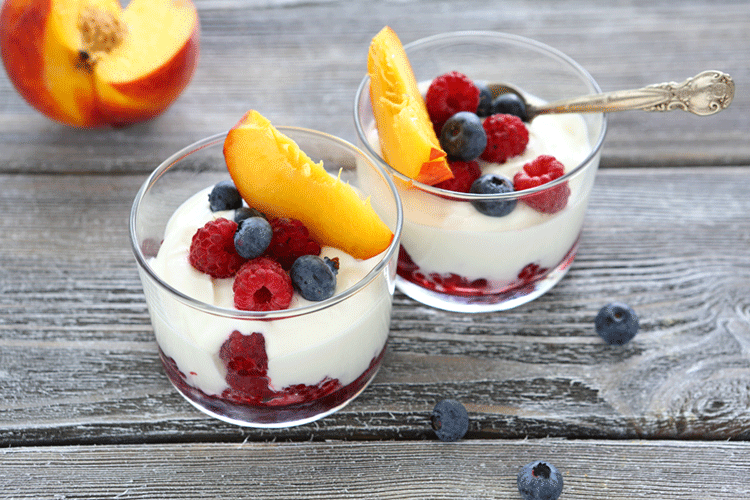1. Yogurt manufacturers are cleaning up their label.
Yogurt, started its life with simple ingredients during a time where refrigeration and shelf stability was limited. In the past, yogurt textures depended on the natural cultures in the environment and milk type used. Today, there is a spectrum of yogurt textures littered on the retail shelves. This is partly due to the use of varying stabilizers, fruit fillings, processing techniques and dairy bases in addition to the cultures.
Right when yogurt manufacturers had dialed in their formulation and put their processes on auto-pilot, the market shifted. This shift was towards cleaner labels. It is a marvel that consumers are actually glancing away from their smartphones to read food labeling. And using their own biases, they decide what is considered natural or not in a split second. As a result, some of these stabilizers are not as natural sounding to the average consumer after all.
Yogurt may be one of those foods carrying a health halo. However, labeling is becoming king in this market. So yogurt manufacturers took note of the label reading and began to re-formulate their yogurts to serve their target consumer base.
2. Clean label is a global trend hitting all foods including yogurt.
Creating natural sounding labels is not an isolated incident. This clean label movement is prevalent in Europe, North America and Australia/New Zealand. There is also a smattering of demand in Asia, South America and Africa.
Most would assume only highly processed food manufacturers are weeping heavily over the market shift to natural labels. However, food manufacturers are realizing that it affects all foods and beverages in this market. Those manufacturers proactively benchmarking their products’ labels are the front-runners in this competitive scene.
3. There are a variety of stabilizers used in yogurts.
Varying stabilizer systems are used in yogurts. For instance, some of the common stabilizers include the following: pectin, modified starch, dairy proteins, cellulose gel, locust bean gum, gelatin, alginates and carrageenan. Each stabilizer either alone or in combination provides improved body and texture, increased firmness, minimal separation or syneresis and suspension of particulates like fruit.
4. There are clean label stabilizers available in the market.
Since there is no regulated definition for natural or clean label, formulators scramble to understand which ingredients are safe havens. No matter which ingredient comes into question, there is some sort of bias for or against it. Yogurt manufacturers need to understand their target consumer’s label sensitivities. For instance, one stabilizer can be considered natural to one consumer base but not to another depending on the brand.
This is not a testimony saying one stabilizer trumps the other. This blurb is to point out that manufacturers should be aware there is no one size fits all when it comes to selecting clean label stabilizers for yogurts. So suppliers are burning the midnight oil in order to launch new options into the marketplace.
5. Citri-Fi® citrus fiber in clean label yogurt is an ideal fit.
For those still scratching their heads over this whole ordeal, there is one natural ingredient they should consider – citrus fiber. Although this is not one of the usual suspects when formulating yogurt, there is one feature that rules – clean label. Within the U.S., the USDA approved the following labeling for dairy products – dried citrus pulp or citrus flour.
Ok, so it is clean label. So why choose citrus fiber in yogurt?
There are several citrus fibers in the marketplace, however, they are not all the same. Citrus fiber’s composition and structure tell the real story behind its stellar functionality. For instance, Citri-Fi natural citrus fiber is created from byproduct of the juicing processing. The patented physical process opens up the fiber to provide high water holding and emulsification properties. Yes! This can provide multiple functionalities in yogurts.
Citrus Fiber Incorporation and Usage
Citri-Fi, a clean label stabilizer, holds onto the water and fat in the system and stabilizes it over time. As a result, this natural ingredient improves the thickness and texture. Less is more when using this natural citrus fiber in yogurt. The recommended usage level is between 0.1% to 0.6%. However, higher usage levels create thicker and creamier yogurts. Citri-Fi comes in a few particle sizes which also helps target specific yogurt textures.
The incorporation process into clean label yogurt is simple. First the cream, milk or any other dairy base are mixed together. This clean label stabilizer powder is slowly added into a vortex while mixing at high speed. The batch is kept lightly agitated to prevent settling until pumped into a pasteurization unit. Once through, the mixture cools down to 43°C and is filled into clean containers. The culture is added and then the containers are incubated at 43°F until a pH of 4.4 to 4.5 is reached. That is about eight hours.
Citri-Fi clean label stabilizer is non-GMO, allergen-free and gluten-free. It has no E-number which is key in certain markets. This natural ingredient is plant-based and vegan. So there is opportunity to use this natural ingredient in dairy-free systems to improve stability, thickness and texture.
Have more questions or need a sample, Click Here!



